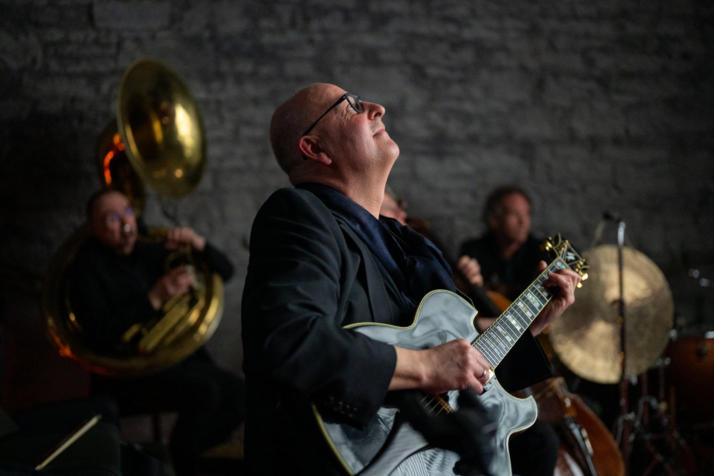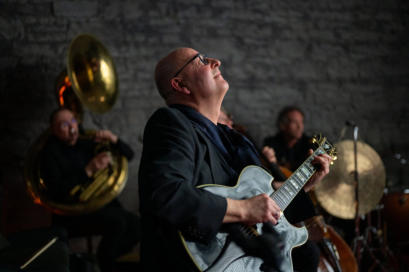
Werner Küspert

Interview-Auszug (English version below):
„…Im Jazz ist es ja ganz besonders wichtig, nicht nur einen eigenen Stil, sondern eine eigene improvisatorische
Sprache zu entwickeln. Ich glaube, dass alle meine Musiker einen eigenen, unverkennbaren Stil gefunden haben, für
den bei unseren Stummfilm-Projekten sehr viel Raum ist.
Ich habe nicht nur komplette Stücke geschrieben, sondern auch relativ komplexe Strukturen geschaffen, innerhalb
derer sich die Musiker improvisatorisch bewegen und vor allem in Interaktion zueinander treten und zudem auf die
Bilder reagieren bzw. Bild- und Filmsequenzen musikalisch vorbereiten.
Unser Verfahren, dem Film einen Ton zu geben, ist recht komplex und nebenbei ganz schön anstrengend, auch
physisch. Die traditionelle Stummfilmbegleitung war in der Frühzeit des Kinos für die Musiker relativ unkompliziert:
die Pianisten hatten ein freies Repertoire, da wurde nach Herzenslust drauf los gespielt. Für Ensembles war die Sache
schon etwas komplexer, aber immer noch überschaubar: fertige Partitur, der Dirigent muss zwar auf den Film
reagieren – letztlich die gleiche Situation wie bei der Oper, im Ergebnis mit ebenso geringen Risiken und ebenso
vorhersehbar, da ja vorwiegend vorgefertigt.
Bei uns läuft das so, dass wir ein komplettes Film-Manuskript haben (ich habe quasi nachträglich ein Drehbuch
geschrieben mit Time-Code), in dem die Kompositionen und improvisatorischen Strukturen notiert sind. Es müssen
also alle Musiker sowohl das Manuskript verfolgen, den Film natürlich, auf mein Dirigat achten und immer
musikalisch im Blick haben, was die Kollegen gerade ad hoc komponieren (also improvisieren).
Nach über 200 verschiedenen „StummFilmLiveJazz“-Projekten (in sehr unterschiedlichen Besetzungen) glaube ich, ein
Verfahren gefunden zu haben, das für die Musiker genügend Freiraum lässt, aber dennoch so klare Strukturen
schafft, dass auch komplexere Kompositionen Platz haben.
Das ist oft ganz schön kompliziert und verlangt uns Musikern so viel an höchster Konzentration ab, wie ich es sonst
eigentlich in keiner anderen Bühnen-Situation erlebe.
Der Begriff „zeitgenössischer Jazz“ ist leider nur sehr vage, aber mit engeren Definitionen kann ich leider nicht
dienen. Vorbilder habe ich eigentlich keine; es gibt natürlich sehr, sehr viele Musiker und Komponisten, die mich
beeindrucken und zu denen ich ehrfurchtsvoll aufschaue, aber ich hatte nie das Bestreben, so zu klingen wie einer
der großen Meister...”
Interview excerpt:
"...In jazz it is particularly important not only to develop one's own style, but also one's own improvisational language.
I believe that all my musicians have found their own distinctive style, for which there is a lot of room in our silent
projects.
I have not only written complete pieces, but also created relatively complex structures within which the musicians
move improvisationally and, above all, interact with each other and also react to the images or prepare image and
film sequences musically.
Our process of giving the film a sound is quite complex and, besides, quite exhausting, also physically. In the early
days of cinema, traditional silent film accompaniment was relatively uncomplicated for the musicians: the pianists
had a free repertoire, so they played to their heart's content. For ensembles, things were a bit more complex, but still
manageable: a finished score, the conductor has to react to the film - ultimately the same situation as with opera,
with just as few risks and just as predictable a result, since it is mainly prefabricated.
For us, it works like this: we have a complete film manuscript (I wrote a script with time code afterwards, so to speak),
in which the compositions and improvisational structures are notated. So all the musicians have to follow the
manuscript, the film of course, pay attention to my conducting and always have a musical eye on what their
colleagues are composing ad hoc (i.e. improvising).
After more than 200 different "StummFilmLiveJazz" projects (in very different instrumentations), I believe I have found
a procedure that leaves enough freedom for the musicians, but still creates such clear structures that there is room
for more complex compositions.
That is often quite complicated and demands so much of the highest concentration from us musicians that I don't
really experience in any other stage situation.
The term "contemporary jazz" is unfortunately only very vague, but I can't serve with narrower definitions. I don't
really have any role models; there are of course very, very many musicians and composers who impress me and
whom I look up to with reverence, but I have never had the ambition to sound like one of the great masters..."
www.wernerkuespert.de

Werner Küspert

Interview excerpt:
"...In jazz it is particularly important not only to develop
one's own style, but also one's own improvisational
language. I believe that all my musicians have found their
own distinctive style, for which there is a lot of room in our
silent projects.
I have not only written complete pieces, but also created
relatively complex structures within which the musicians
move improvisationally and, above all, interact with each
other and also react to the images or prepare image and
film sequences musically.
Our process of giving the film a sound is quite complex and,
besides, quite exhausting, also physically. In the early days of
cinema, traditional silent film accompaniment was relatively
uncomplicated for the musicians: the pianists had a free
repertoire, so they played to their heart's content. For
ensembles, things were a bit more complex, but still
manageable: a finished score, the conductor has to react to
the film - ultimately the same situation as with opera, with
just as few risks and just as predictable a result, since it is
mainly prefabricated.
For us, it works like this: we have a complete film manuscript
(I wrote a script with time code afterwards, so to speak), in
which the compositions and improvisational structures are
notated. So all the musicians have to follow the manuscript,
the film of course, pay attention to my conducting and
always have a musical eye on what their colleagues are
composing ad hoc (i.e. improvising).
After more than 200 different "StummFilmLiveJazz" projects
(in very different instrumentations), I believe I have found a
procedure that leaves enough freedom for the musicians,
but still creates such clear structures that there is room for
more complex compositions.
That is often quite complicated and demands so much of the
highest concentration from us musicians that I don't really
experience in any other stage situation.
The term "contemporary jazz" is unfortunately only very
vague, but I can't serve with narrower definitions. I don't
really have any role models; there are of course very, very
many musicians and composers who impress me and whom
I look up to with reverence, but I have never had the
ambition to sound like one of the great masters..."



























